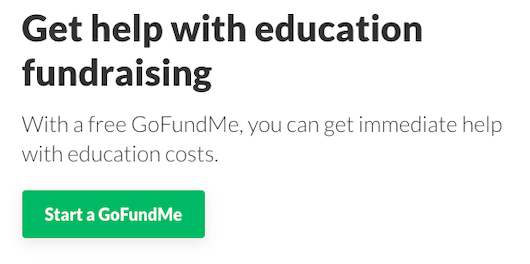If educational funding wasn’t hard to come by prior to the COVID-19 pandemic, it certainly is now.
According to the Learning Policy Institute, funding for state education could decrease more than 20 percent in the 2020-2021 school year.
With such severe cuts to an already tight budget, how are you to provide meaningful classroom experiences for students?
While it takes determination and effort, you can look to your community for support.
You can use these 20 tips to navigate the process of finding, securing, and maintaining class sponsorships.
The Process
Step 1: Finding Class Sponsorships
Step 2: Securing Class Sponsorships
Step 3: Maintaining Class Sponsorships
Step 1: Finding Class Sponsorships

Finding a potential sponsor can often be the hardest part of landing a sponsorship. How do you find one? To whom do you reach out? Where do you start?
1. Reach out to businesses that have sponsored your school’s programs in the past.
Quite often, local businesses and organizations sponsor sports teams, clubs, and programs.
You can reach out to your school’s administrators, coaches, club leaders, and PTA to compile a list.
2. Ask your students’ parents.
You never know what connections your students’ parents might have. They could be local business owners, friends of business owners, or they might work for companies that would be interested in sponsoring your classes.
Finding a sponsor this way can be as simple as emailing parents or sending your students home with a letter.
3. Apply for a Perkins grant.
It can be intimidating to apply for a Perkins grant, intimidating enough to keep educators from applying all together, but it is a fantastic opportunity to receive funding for your classes.
The Perkins grant supports programs that develop academic, career, and technical skills, so students have equal opportunities and are more prepared to obtain jobs.
Read this article to learn more about applying for a Perkins grant.
4. Reach out to credit unions in your community and state.
Credit unions are known for being very involved in their communities. In fact, most have a department dedicated to supporting schools.
Credit unions are especially interested in providing students with opportunities to learn financial literacy, so if you need funding for a personal finance course, this is a great option.
For example, Idaho Central Credit Union made a record-breaking donation to provide every high school student in Idaho with the opportunity to use Mimic Personal Finance for free for five years. If you know of a credit union in your area that may be interested in doing something similar, you can refer them here.
5. Find high school alumni that own businesses.
Ask around at your school. Chances are that you, a coworker, or an administrator will know of a handful of alumni who are business owners.
Sometimes, school spirit goes a long way, and alumni will be more than happy to help those attending their old stomping grounds.
GoFundMe provides tips for securing alumni donations. The article is written for universities seeking donations, but many of the tips ring true for high schools as well.
6. Reach out to businesses that might donate a percentage of revenue.
Occasionally, a business will agree to donate a percentage of its revenue to a cause. For example, a Wendy’s in Idaho Falls, Idaho, donated part of an evening’s revenue to a local elementary school.
Sometimes businesses are more comfortable going this route because it allows them to give donations that are realistic in comparison to their profits.
Step 2: Securing Class Sponsorships

You found potential sponsors, but the work isn’t quite done. Now, you’ve got to make the class sponsorship appealing.
7. Tell potential sponsors your story.
Paint a picture for potential sponsors, and don’t be afraid to get a little personal. Tell them about the difficulties you face as a teacher. Explain how hard it is to provide valuable resources for students without proper funding. Tell them about your students, your course, the requirements students must meet, etc.
It’s important that you help potential donors see how beneficial a sponsorship would be for your students.
8. Start a fundraiser on GoFundMe, and share it with your community.
Collecting donations doesn’t have to be a daunting task. It can be as simple as creating a GoFundMe page.
Follow these steps to create a GoFundMe page:
1. Visit GoFundMe.com/start.
2. Select the education category.

3. Click “Start a GoFundMe.”

4. Fill in the required fields to sign up, and click “Next.”
5. Enter information about your fundraiser.
You can edit this later, so don’t worry too much about perfecting it in the beginning.
6. Share your fundraiser.
This is the most important step. You might have a GoFundMe fundraiser set up, but you won’t raise money until people know about it.
Share your GoFundMe link on social media. Print the link on programs for school events and on flyers that you can send home with your students.
There are plenty of options for spreading the word. Don’t be afraid to get creative!
If you send your GoFundMe link to Stukent, we will share it with our business partners as well. Email the vice president of business development at travis@stukent.com.
See “Creating a GoFundMe from Start to Finish” for more information about setting up a fundraiser.
9. Invite potential sponsors to visit your class.
Rather than telling potential sponsors about your course, show them.
At Morgan High School in small-town Ohio, technology and accounting instructor Norvel Crandall’s students will use Mimic Personal Finance for free, beginning in the fall of 2020. All because she found an ally in a local insurance agent after he visited her classroom.
“He was just thrilled,” said Norvel. “He really was the one who just spearheaded getting the rest of the buy-in for me.”
The agent was impressed with Norvel’s use of Mimic Personal Finance and enlisted help from the rotary club and community to secure funding for her classes.
Find those in your community who would be interested in the work you’re doing in class — they just might be inspired enough to help you find sponsors.
10. Start early.
Businesses have a lot of expenses to manage. Adding another to the list can be a big commitment for most, and it can take time for them to decide to become sponsors.
Give your potential sponsor a few months at the least to get comfortable with the proposition.
In addition, it can take time to transfer and distribute funds within your school or district. Account for that as you plan and execute your search, so you don’t have to rush through the process and overwhelm potential sponsors.
11. Hold a fundraiser.
A fundraiser can be as simple as a car wash or as extravagant as a charity ball. You can enlist the help of other teachers and administrators to plan, and you can invite parents, community members, and businesses to the event.
This can be a great opportunity to get your entire community involved and to build awareness of the need for funding.
See Sign Up Genius’ ideas for fundraisers.
12. Send a letter.
If you want to reach out to multiple businesses at once, try sending a sponsor request letter.
The letter can be an invitation to a fundraiser, or it can simply inform the recipient about the sponsorship opportunity. When you write the letter, keep in mind that you want to appeal to the emotions of the potential sponsor — connect with them.
Click the button below to download Stukent’s sponsor request letter template for Mimic Personal Finance.
13. Highlight the opportunity to deduct charitable contributions.
Donations to government-supported public schools are eligible for tax deduction. This is a major benefit for businesses that become sponsors. But, it’s up to you to communicate this opportunity and to make the donation process as simple for them as you can.
While donations to public schools can be used for tax deductions, donations to private schools can only be deducted if the school is a qualified nonprofit.
If you teach at a private school and your school has not yet applied for 501(c)(3) status, you should urge it to do so. Potential sponsors will appreciate the opportunity to deduct donations.
14. Send potential sponsors to Stukent.
From planning lessons to grading papers, you are beyond busy. Stukent understands that, so we’ve built a program that allows businesses to work directly with us to sponsor financial literacy education in their areas.
If you want to use Mimic Personal Finance in your course but don’t have the funds to purchase it or the time to secure a sponsor, send businesses our way! All you need to do is share this page with potential sponsors — we’ll handle everything else.
Step 3: Maintaining Class Sponsorships

You secured a sponsor … now what? This is your opportunity to turn the sponsorship into a long-lasting partnership.
15. Use a tiered donation model.
This provides clear decisions for the sponsor and allows them to choose whichever options fit their needs best.
Take the following model for example:
- $250 — The sponsor’s logo is added to a poster in the gymnasium.
- $500 — The sponsor’s logo is printed on the backs of spirit T-shirts.
- $750 — The sponsor’s logo is printed on the sleeves of spirit T-shirts and added to a poster in the gymnasium.
- $1,000 — The sponsor’s logo is printed on the sleeves of spirit T-shirts and added to a poster in the gymnasium. Also, you will share a thank-you video for the sponsor on the school’s social media profiles and website.
16. Hold a sponsorship day.
Invite your sponsor to visit your classroom on Sponsorship Day to share information about their business. You can even invite them to share insights on a subject you’re teaching.
Sponsors appreciate opportunities to spread awareness of their businesses and would enjoy a chance to meet the people that are impacted by their donations.
17. Incorporate the sponsor in an assignment or project.
Let’s say you teach economics. During a lesson on entrepreneurship, you could assign a project requiring students to map out the costs of starting a business and to present a proposed budget for the business.
You could even incorporate a sponsorship day, and have the sponsor come in at the beginning of the project to share entrepreneurial insights. Then, at the end of the project, have them judge the students’ final presentations.
18. Make a thank-you video.
Gratitude goes a long way.
Film a thank-you video with your students. Have a handful of them share how they were impacted, thanking the sponsor for the donation.
You can also post the video on your school’s website and social media profiles. You’ll provide positive PR for your sponsor, and at the very least, they will feel appreciated.
Check out this thank-you video from Simon Fraser University.
19. Update the business on students’ success and gratitude.
Don’t hesitate to update the sponsor on your students’ success. They will want to know that their donations are making a difference.
This can be as simple as an email here and there or a quick phone call.
20. Incorporate the sponsor in your school’s marketing material.
This way, you can choose from a variety of options to build a package of benefits that will best fit your sponsor’s needs.
You can add your sponsor’s logo to
- Flyers
- Posters
- School website
- Programs
- T-shirts
- Digital school sign
You can even advertise your sponsor via
- Announcements at sporting events, plays, concerts, etc.
- Radio
- Social media
Don’t Give Up
Good things take time! You might find a sponsor on your first try, but you might not. That’s OK. Try, and try again.
With the help of these tips, you can perfect your process for finding, securing, and maintaining class sponsorships.







